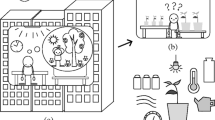Abstract
The purpose is to study and discuss the design of green intelligent buildings based on biophysical design concepts under the background of the Internet of Things (IoT). Firstly, the biomimetic concept is applied to the design and exploration of children's medical building space, and the biophilia color design method is proposed for children's medical building space and green building lighting system based on the IoT. Meanwhile, the influencing factors of biophilia skin color are studied on children's psychological stress relief. The children's medical building designed with Deep Belief Network in the Deep Learning field can effectively detect human motion in various areas, and the lighting system can be automatically activated by passers-by. Then, Questionnaire Survey method is used to understand the practicability and preference of users and verify the effect of biophilia color design. Consequently, an intelligent dimming lighting system is designed by ZigBee technology. The experiment results indicate that the illuminance error is small for the proposed medical green intelligent building lighting system based on the IoT. Therefore, the implantation of biophilia color in children's s medical building space can promote children’s physical and mental health recovery and have a positive impact on people's s emotions, thereby achieving the role of environmental therapy. Moreover, the proposed medical green intelligent building lighting system based on the IoT can detect the position illuminance of children's s medical buildings and realize intelligent dimming.










Similar content being viewed by others
References
Ali HZ, Kabir S, Ullah G (2021) Indoor scene recognition using ResNet-18. Int J Res Publ https://doi.org/10.47119/IJRP100691120211667
Andreucci MB, Loder A, Brown M et al (2021) Exploring challenges and opportunities of biophilic urban design: evidence from research and experimentation. Sustainability 13(8):4323
Barbiero G (2021) Affective ecology as the development of biophilia hypothesis. Vis Sustain 16:21–37
Chegini H, Naha RK, Mahanti A et al (2021) Process automation in an IoT–Fog–Cloud ecosystem: a survey and taxonomy. IoT 2(1):92–118
Chu Y, Yue X, Yu L et al (2020) Automatic image captioning based on ResNet50 and LSTM with soft attention. Wirel Commun Mobile Comput 2020:1–7
Fan X, Susan F, Long W et al (2017) Security analysis of Zigbee. MWR InfoSecur, 1–18.
Hosny KM, Kassem MA, Fouad MM (2020) Classification of skin lesions into seven classes using transfer learning with AlexNet. J Digital Imaging 33(5):1325–1334
Hussein A, Samara G (2017) Coordinator location effects in AODV routing protocol in ZigBee mesh network. Int J Comput Appl 127(8):1–7
Kumar KS, Hemasree V (2021) Age detection based on facial image using fusion extreme learning machine classifier. Turk J Comput Math Educ (TURCOMAT) 12(6):4535–4546
Liu B, Shu L (2015) Analysis of biological design of rehabilitation Landscape. Landsc Archit 05:123–128
Mehaffy M (2012) Biophilic design: the theory, science, and practice of bringing buildings to life KellertStephen R. HeerwagenJudith H. MadorMartin L. Hoboken, NJ, USA Wiley. Proc Inst Civil Eng Urban Des Plan 165(3):193
Meka S, Fonseca B (2020) Improving route selections in ZigBee wireless sensor networks. Sensors 20(1):164
Nayak V, Krishna A V, Rangari A et al (2016) Development of street lighting system with vehicular sensing at low light intensity based on ZigBee intelligence. IEEE, pp. 1–4.
Noura M, Atiquzzaman M, Gaedke M (2019) Interoperability in the Internet of Things: taxonomies and open challenges. Mobile Netw Appl 7:1–14
Oktian YE, Witanto EN, Lee SG (2021) A conceptual architecture in decentralizing computing, storage, and networking aspect of IoT infrastructure. IoT 2(2):205–221
Olubunmi OA, Xia PB, Skitmore M (2016) Green building incentives: a review. Renew Sustain Energy Rev 59:1611–1621
Precup RE, David RC, Petriu EM (2016) Grey wolf optimizer algorithm-based tuning of fuzzy control systems with reduced parametric sensitivity. IEEE Transactions on Industrial Electronics, pp. 527–534.
Ronen E, Shamir A, Weingarten AO et al (2018) IoT goes nuclear: creating a Zigbee chain reaction. IEEE Secur Privacy 16(1):54–62
Saxe A, Nelli S, Summerfield C (2021) If deep learning is the answer, What is the question? Nat Rev Neurosci 22(1):55–67
Theckedath D, Sedamkar RR (2020) Detecting affect states using VGG16, ResNet50, and SE-ResNet50 networks. SN Comput Sci 1(2):1–7
Theckedath D, Sedamkar RR (2020) Detecting affect states using VGG16, ResNet50 and SE-ResNet50 networks. SN Comput Sci 1(2):1–7
Wagiman KR, Abdullah MN (2018) Intelligent lighting control system for energy savings in the office building. Indones J Electr Eng Comput Sci 11(1):195–202
Walborn F (2014) Eric fromm–sciencedirect. Religion in Personality Theory, pp. 139–181.
Wang G, Li N, Xiong X et al (2017) Schemes evaluation for drilling of carbon fiber reinforced plastics based on fuzzy theory. Comput Integr Manuf Syst 23(2):325–332
Wilson EO (2017) Biophilia and the conservation ethic. Evolutionary perspectives on environmental problems. Routledge, pp. 250–258.
Xue F, Lau SSY, Gou Z et al (2019) Incorporating biophilia into green building rating tools for promoting health and wellbeing. Environ Impact Assess Rev 76:98–112
Yu X, Wang SH (2019) Abnormality diagnosis in mammograms by transfer learning based on ResNet18. Fundam Inform 168(2–4):219–230
Acknowledgments
The authors acknowledge the help from the university colleagues.
Funding
This research received no external funding.
Author information
Authors and Affiliations
Contributions
All authors listed have made a substantial, direct, and intellectual contribution to the work, and approved it for publication.
Corresponding author
Ethics declarations
Conflict of interest
All Authors declare that they have no conflict of interest.
Ethical approval
This article does not contain any studies with human participants or animals performed by any of the authors.
Informed consent
Informed consent was obtained from all individual participants included in the study.
Additional information
Publisher's Note
Springer Nature remains neutral with regard to jurisdictional claims in published maps and institutional affiliations.
Rights and permissions
About this article
Cite this article
Yu, T., Yang, X. & Sang, P. Design strategy of green intelligent building using deep belief network. Int J Syst Assur Eng Manag 14, 196–205 (2023). https://doi.org/10.1007/s13198-021-01513-0
Received:
Revised:
Accepted:
Published:
Issue Date:
DOI: https://doi.org/10.1007/s13198-021-01513-0




